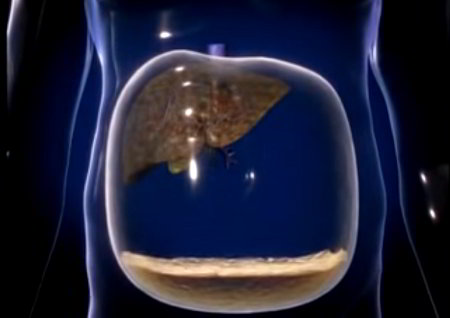Ascites: Overview
Ascites is a build-up of fluid in the peritoneal cavity – the space between the lining of the abdomen and abdominal organs. It can be caused by liver disease, various cancers, congestive heart failure, or kidney failure.
- see your health summarized and in detail
- identify any nutritional deficiencies
- have a doctor review your case (optional)
Causes and Development; Contributing Risk Factors

The most common cause of ascites is liver cirrhosis. In fact, many of the risk factors for developing ascites are the same as those for cirrhosis.
When portal hypertension develops as a result of liver cirrhosis, blood bypasses the liver and is diverted to abdominal peritoneal vessels. Then, due to increased capillary pressure, fluid leaks into the peritoneal cavity.
The most common risk factors for ascites include hepatitis B, hepatitis C, chronic alcohol abuse, congestive heart failure, malignancy, and kidney disease.
Signs and Symptoms
Mild ascites (defined as less than 400ml of fluid being present in an adult) is often without symptoms. As more fluid accumulates, abdominal distension, pain, discomfort, and bloating are frequently seen.
Diagnosis and Tests
Ascites has traditionally been classed as either 'transudative' or 'exudative', based on the amount of protein found in the fluid. A more useful classification system, the Serum Ascites Albumin Gradient (SAAG), has since been developed based on the amount of albumin in the ascitic fluid compared to the amount of albumin in the blood.
The SAAG value for ascites caused by portal hypertension (cirrhosis or congestive heart failure for example) is generally more than 1.1; the value for ascites due to other causes (cancer or pancreatitis for example) is less than 1.1.
If more than 500ml of ascites fluid is present, it can be seen during physical examination as bulging and fluid waves as the doctor palpates the abdomen. Smaller amounts may be detected with an ultrasound scan of the abdomen, and are occasionally found by accident during an ultrasound or CT scan that is being performed for other reasons.
It is important to diagnose the underlying condition(s) that are causing ascites. Blood work is an essential tool and may include a complete metabolic panel and coagulation (clotting) panel.
Analysis of the fluid itself may be necessary. A needle is inserted into a sterilized area of the abdomen and a small sample of fluid is withdrawn.
The liver and kidneys may also be tested:
- 24-hour urine collection
- Electrolyte levels
- Kidney function tests
- Liver function tests
- Urinalysis
Treatment and Prevention
The type of treatment depends largely on the underlying cause. Because cirrhosis of the liver is the main cause, frequent treatments include:
- Alcohol avoidance
- Limiting salt intake to under 1,500mg per day
- Limiting fluid intake
- Diuretics (water pills) taken in the morning to avoid frequent nighttime urination
- Therapeutic paracentesis (removing large amounts of fluid through a needle inserted into the abdominal cavity)
- Surgery to reduce the portal pressure
- Liver transplant in cases of end-stage liver disease.
Complications
A large accumulation of fluid may cause breathing difficulties by compressing the diaphragm and forming pleural effusion. Gut bacteria may invade the ascites (peritoneal) fluid and cause serious infection. Ascites related to cirrhosis may lead to progressive kidney failure.
On This Page
Ascites:Signs, symptoms & indicators of Ascites:
Symptoms - Abdomen
Symptoms - Respiratory
 Shortness of breath when at rest
Shortness of breath when at rest
Shortness of breath can occur with large ascites that causes pressure on the diaphragm and fluid around the lungs.
Risk factors for Ascites:
Circulation
Glandular
Nutrients
Organ Health
Tumors, Malignant
 Cancer, General
Cancer, General
Malignant ascites is typically due to advanced cancers of the organs in the abdominal cavity. Examples include ovarian cancer in particular, as well as colon cancer, pancreatic cancer, stomach cancer, breast cancer, lymphoma, lung cancer, and cancer of the uterus or liver.
Ascites suggests the following may be present:
Lab Values
Organ Health
Click to see sample report
Your body is a highly complex, interconnected system. Instead of guessing at what might be wrong, let us help you discover what is really going on inside your body based on the many clues it is giving.
Our multiple symptom checker provides in-depth health analysis by The Analyst™ with full explanations, recommendations and (optionally) doctors available for case review and answering your specific questions.
KEY








